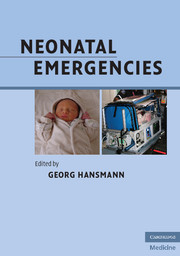Book contents
- Frontmatter
- Contents
- List of contributors
- Foreword (1)
- Foreword (2)
- Preface
- Acknowledgments
- Section 1 Organization of neonatal transport
- History and challenges of neonatal emergency transport services (NETS)
- Interdisciplinary approach for neonatal emergencies
- Neonatal emergency call: what the neonatology team would like to know from obstetricians and midwives
- Coordinating health care providers after a neonatal emergency call
- What the neonatologist would like to find in the delivery room
- What the neonatologist does not want to find in the delivery room
- Definitions and abbreviations in neonatology, pediatric cardiology, neonatal emergency transport service (NETS), and obstetrics
- References (Section 1)
- Section 2 Basics in cardiopulmonary resuscitation of newborn infants
- Section 3 Classic and rare scenarios in the neonatal period
- Section 4 Transport
- Section 5 Appendix
- Index
- Plate section
Interdisciplinary approach for neonatal emergencies
from Section 1 - Organization of neonatal transport
Published online by Cambridge University Press: 05 March 2012
- Frontmatter
- Contents
- List of contributors
- Foreword (1)
- Foreword (2)
- Preface
- Acknowledgments
- Section 1 Organization of neonatal transport
- History and challenges of neonatal emergency transport services (NETS)
- Interdisciplinary approach for neonatal emergencies
- Neonatal emergency call: what the neonatology team would like to know from obstetricians and midwives
- Coordinating health care providers after a neonatal emergency call
- What the neonatologist would like to find in the delivery room
- What the neonatologist does not want to find in the delivery room
- Definitions and abbreviations in neonatology, pediatric cardiology, neonatal emergency transport service (NETS), and obstetrics
- References (Section 1)
- Section 2 Basics in cardiopulmonary resuscitation of newborn infants
- Section 3 Classic and rare scenarios in the neonatal period
- Section 4 Transport
- Section 5 Appendix
- Index
- Plate section
Summary
Team work of paramedics, nurse practitioners, and neonatologists in the neonatal emergency transport service
In the neonatal emergency transport service (NETS), effective coordination between paramedics, highly specialized neonatal intensive care unit (NICU) nurses or nurse practitioners (NP), and neonatal emergency doctors (NETS-MD) is essential. The NETS-MD – especially in the first weeks in service – is well advised to take advantage of the experience of paramedics and NP, particularly in terms of transport logistics. That said, the NETS-MD, preferably with a minimum of 12 months of NICU experience, should lead the initial care/neonatal resuscitation and subsequent transport (i.e., runs code and transport). Depending on their experience level, two paramedics or one experienced NICU nurse or NP may go with the NETS-MD to the emergency site, in order to perform initial care/neonatal resuscitation. This particularly applies to emergent deliveries of extremely premature or sick infants, or preterm twins (32 + 0/7 till 35 + 0/7 weeks' gestation), who need simultaneous initial care (see Table 1.1).
•In uncomplicated cases, the common goal is for active initial care (including neonatal resuscitation) to be provided by the least experienced paramedic, RN, NP or doctor under the supervision of highly qualified and experienced health care providers. Nobody gets better just by watching, and there is no learning by osmosis.
•If problems occur at the emergency site, e.g., after a cesarean (c-section) section of twins, the NETS-MD should either call the anesthesiologist on service for help, or, if available, additional neonatal or pediatric emergency transport services.
- Type
- Chapter
- Information
- Neonatal Emergencies , pp. 5 - 8Publisher: Cambridge University PressPrint publication year: 2009

